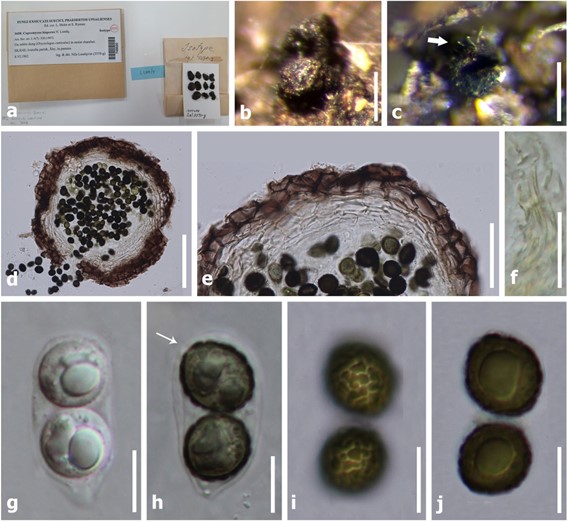Copromyces bisporus N. Lundq., Arch. für Botanik, Ser. 2 6: 328 (1967)
MycoBank number: MB 328886; Index Fungorum number: IF 328886; Facesoffungi number: FoF 10051; Fig. 67
Coprophilous on rabbit dung. Sexual morph: Ascomata 200–250 µm (x̄= 235 µm, n= 10) diam., cleistothecial, solitary, uniloculate, superficial, globose to subglobose, membranaceous, dark brown, with hyaline surface hairs. Peridium 30–50 µm wide, membranaceous, composed of dark brown to hyaline cells of textura angularis. Asci (24–)26–32(–35) × 12–15(–17) µm (x̄= 30 × 13 µm, n = 50), 2-spored, ovoid, apex rounded, short pedicellate. Ascospores (11–)12–16(–20) µm (x̄= 15 µm, n= 50) diam., globose to subglobose, bright yellow, becoming olivaceous, brown to black at maturity, aseptate, guttulate, with a germ pore and irregular plate-like wrinkles on the surface. Asexual morph: Undetermined.
Material examined: Sweden, Skane, Ivetofta parish, Aby, in pasture, on rabbit dung, 8 June 1962, N. Lundqvist (BPI- 749020, isotype).
Known hosts and distribution: On dung of rabbit (Oryctolagus cuniculus) in Sweden (type locality) (Lundqvist 1967); on rabbit and fox dung in Venezuela (Avila et al. 2002).

Fig. 67 Copromyces bisporus: (BPI-749020, isotype). a Herbarium material label. b Ascoma. c Ascoma with hyaline hairs (arrow). d Vertical section of ascoma. e Peridium. f Evanescent filaments (stained in Melzer’s reagent). g–j Asci stained in 5% KOH (h. arrow marks germ pore, h–j are the same ascus). Scale bars: b. c = 200 µm, d = 100 µm, e = 50 µm, f = 20 µm, g–j = 10 µm
